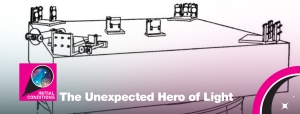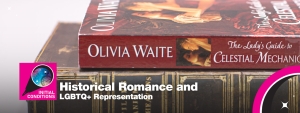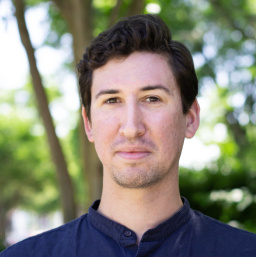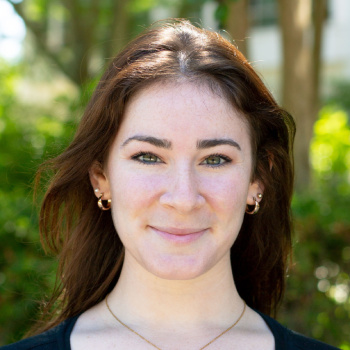
Perhaps because she was a woman, or perhaps because she was American, Eunice Foote did not receive credit for her 1856 discovery of the heat-absorbing properties of carbon dioxide and water vapor. In this episode, we will tell the story of the once forgotten climate scientist, activist, and inventor, Eunice Foote, with help from Sir Roland Jackson of the Royal Institute and University College London. Though little is known about her or her perspective, her life and scientific contributions contextualize not only a history of climate change science but of the experience of women in science. This episode starts our journey through the history of our understanding of the greenhouse effect and global warming.

Sir Roland Jackson is the author of The Ascent of John Tyndall: Victorian Scientist, Mountaineer, and Public Intellectual, co-editor of The Poetry of John Tyndall, and general editor of Tyndall’s correspondences. Though his background is in biochemistry, he has experience in public engagement in science and science history. Jackson is currently a Visiting Fellow of the Royal Institution and Honorary Research Fellow in the Department of Science and Technology Studies at University College London.
Guest: Sir Roland Jackson
Speakers: Maura Shapiro and Justin Shapiro
Initial Conditions Episode 1: Eunice Foote
Date: April 5, 2022
MAURA: (voiceover) We're at the Niels Bohr Library and Archives in College Park, MD. And let's just say, we're on a bit of a mission.
ALLISON: We're going into the stacks. We're going to find the Scientific American article that mentions Eunice Foote.
MAURA: So exciting. I cannot wait.
MAURA: (voiceover) I could not wait, because Eunice Foote is larger than life to me. She's one of the first scientists known to have experimented on the warming effect of sunlight on different gases. And not only that, though it may or may not immediately be obvious, she was a woman. We're searching for one of the first mentions of Foote's contributions in an issue of Scientific American from 1856.
ALLISON: Now two badges in. Very high security here.
JUSTIN: (voiceover) We're heading for a special collections area, in a climate-controlled section deep in the Archives.
ALLISON: We're going into the stacks. All our collections live in various stacks, but we're specifically going to the second-floor stacks, which contain our archival collections for the most part, as well as the Wenner collection of rare books, as well as some materials that we're just currently working on like this Scientific American volume we're looking for.
MAURA: So here's our Scientific American volume.
ALLISON: Yeah, here it is. You found it on the cart.
MAURA: Let's crack it open.
ALLISON: It was here all the time, yeah.
MAURA: Thank you, Allison.
JUSTIN: (voiceover) Our tour guide is Allison Rein. She's the associate director of library collections and services at the Niels Bohr Library and Archives.
MAURA: It's huge.
ALLISON: It is huge. It's almost like newspaper-sized. And it's very heavily illustrated. And I believe this volume is volume 12, number 1. From September 13th, 1856. So if we just flip to the fifth page, we'll see the article and it's an author list article, but there's a lot of really great stuff that's contained within this single column in this giant, giant book.
MAURA: From the Niels Bohr Library and Archives, at the American Institute of Physics, welcome to Initial Conditions. I'm Maura Shapiro.
JUSTIN: And I'm Justin Shapiro.
MAURA: And in case you're wondering, no. We're not related.
JUSTIN: But we are both fascinated by what the initial conditions of atmospheric research in the 19th century reveal about the evolution of climate science.
MAURA: This is Initial Conditions.
JUSTIN: A physics history podcast.
MAURA: Every physics problem begins with a set of initial conditions that provide the context for physics to happen.
JUSTIN: Likewise, in this podcast, we'll dive into the initial conditions that made science possible. The people, places, and events that have been overlooked and under-studied.
MAURA: And today, we're going to explore the work of an American scientist who had once slipped into obscurity: Eunice Foote.
JUSTIN: Eunice Newton Foote.
MAURA: Right. (laughs) She was born in 1819 and was one of the first scientists to observe that the heat of the sun's rays can have a direct effect on climate temperature. But, before we get into the full story of the talented Miss Foote, there's a matter of this large volume that we've gone through a lot of trouble to find.
JUSTIN: Yes. The Scientific American.
MAURA: And before I put it back, I want to read you a short passage from this article, which by the way, has one of the best titles I've ever seen, Scientific Ladies: Experiments With Condensed Gases.
JUSTIN: All right, I'm ready.
MAURA: Okay. "Our constant readers will remember that several articles from different persons appeared in the last volume of Scientific American related to solar heat at the surface of the Earth. The question was introduced by William Patridge of Binghamton, who took the position that density of the atmosphere, and not the angularity of sun's rays, was the principal reason why it was warmer in the valleys than on the tops of mountains. His views were opposed by other correspondents, but none of them supported their opinions with practical experiments to decide the question. This, we are happy to say, has been done by a lady. A paper was read before the late meeting of the Scientific Association by Professor Henry from Miss Eunice Foote, detailing her experiments to determine the effects of the sun's rays on different gases."
JUSTIN: I can definitely tell that was written in the mid-19th century.
MAURA: Yeah. And it's a bit of a tongue-twister for me, today, to read. Especially since I didn't know that W.M. stands for William. And so this short section of a very short article with no author talks about this wonderful experiment by an American woman named Eunice Foote, who will be the subject of our conversation today. Eunice Foote discovered the heat-absorbing property of carbon dioxide and water vapor in 1856. However, she was forgotten to much of history for 150 years. She conducted an experiment to measure how the sun warms different atmospheric gases and concluded in 1856 about carbon dioxide, "an atmosphere of this gas would give to our Earth a high temperature."
JUSTIN: So it sounds like she's, in 1856, right? In the mid-19th century, kind of... thinking about global warming, we might say. And that, to me, seems like a pretty early date.
MAURA: Right. She's investigating what are the conditions that would create a warmer Earth? I can't stress this enough: 1856. That is a long time ago that we've been asking this question, how will carbon dioxide change our atmosphere? And Eunice Foote said it would give our Earth a high temperature. However, instead, John Tyndall, an Irish physicist, was credited with this discovery until 2011, when Raymond Sorenson, a retired petroleum geologist, happened to stumble upon her work. As I mentioned earlier, ten seconds ago, John Tyndall was forever remembered as the person who discovered that carbon dioxide and water vapor absorb heat. So naturally, the best person to consult on this story would be John Tyndall's biographer, Sir Roland Jackson, of the Royal Institution in London, and the University College London. I found his work while I was writing teaching guides for the Center for History of Physics out of the American Institute of Physics. Sir Roland Jackson had published two papers about Eunice Foote, one in collaboration with Dr. Joseph Ortiz out of Kent State. And these were some of the only academic papers published on this topic. So naturally, I had to reach out to him.
JUSTIN: It's not uncommon for folks with a background in the hard sciences, right, to move into history of science. It happens a lot of the time because sometimes people are just drawn to the stories and the moments when scientific history was made. And so, like some of these folks in the community of historians of science, Sir Roland Jackson has had multiple careers, with a background in biology. He then moved into science communication and is now a historian of science.
MAURA: Here's Roland Jackson.
JACKSON: My background, as you say, I'm a research scientist. I did a doctorate in molecular immunology, in fact. But then got interested in science education and teaching, and spent most of my career in science communication and public involvement in science. And that includes a spell as head of the Science Museum in London and then chief executive of the British Science Association, which of course is the forerunner of the AAAS, the American Association for the Advancement of Science.
MAURA: (voice-over) Not that it's a competition or anything.
JACKSON: More recently, I've become a historian of science. I think partly through looking at the history of those organizations that I worked in, and that includes writing a biography of John Tyndall, a 19th century Irish physicist. And of course publishing papers on Eunice Foote's work.
MAURA: Roland was writing the biography of John Tyndall when he found out about Foote's work. He immediately wanted to know more about what she had done, and if Tyndall had been the first to what he claimed to be the first to, which is experimentally discover the basis for the greenhouse effect. But before we dive into the science and the drama, let's talk a little bit about what the 19th century would have been like for scientists. If you're a physics lover, this would have been the time to be alive and to be a man living in Europe.
JACKSON: Yeah, I think it was a fascinating and exciting time, and quite a fast-changing time actually, because I think many of the ideas that we might now call-- well, that we now call "classical physics," in other words, physics before quantum theory, were really taking shape in that period.
MAURA: They're discovering things like the conservation of energy, they're understanding light as a wave, and heat as a phenomenon that's driven by the motion of particles. And even electricity was really understood in new ways.
JACKSON: And indeed, by Michael Faraday's emerging field theory. And all of that, in that decade, was increasingly grounded in sophisticated experiments and being expressed mathematically in quantitative terms, with a lot of advanced mathematics. Well, and the whole thing required new and often expensive experimental apparatus. It was a real-time of change and development and the production of that new classical physics.
JUSTIN: And as Maura mentioned, there was a lot going on in this community of what we might call proto-physicists. But of course, this was a time before email. It was a time before electronic communication. What you had were mostly letters that folks used to correspond, but of course, mail delivery, both within and among nations, was pretty slow by today's standards. Whereas today, scientists can email and call each other for advice and feedback, and scientific conferences can be and, due to COVID-19, must be held online in many circumstances, incorporating then participants from all over the world. Back then, communication was much slower.
JACKSON: Yes, it's difficult for us now to-- which a historian has to try to do-- to sort of think back to a time when there was not only no internet but no telephone even. No telegraphic communication across the Atlantic, or indeed within Europe. So people were communicating in person by meeting together in small groups, or very, very occasional conferences.
MAURA: Letters of course would take a long time to travel across Europe, and much longer to sail across the Atlantic Ocean. And so while scientists could publish their work in journals, then other scientists would read these journals and know what was happening, it really limited what people knew about what other people were up to in the field. Especially if you're an outsider.
JACKSON: John Tyndall, who is part of this story, had no US correspondence at all in the 1850s.
JUSTIN: The state of science in the United States was very much on the fringes.
MAURA: Right, and that's partially because of geography. There's an entire ocean separating Europe from the United States. And it's partially because the science culture in the US was primarily focused on invention and this applied physics and applied science, which European scientists had this kind of elitist attitude that science for science's sake was somehow better than science for application, and looked down, really, on a lot of the science that was coming out of the US. But also, it should not be missed that the US was still relatively new, and preoccupied by conflict. The 1850s in the United States saw western expansion, urbanization in the Northeast. Slavery was obviously a really big problem at the time. They were just five years away from the Civil War. And people were pursuing science, but again it was more this practical application.
JUSTIN: So this is the context in which Eunice Foote would work. The United States was still becoming a scientific nation. It was still developing the institutions and the connections and the networks necessary to do science on a large scale. And for many Europeans, the US was noticeably further behind in the development of their scientific fields.
MAURA: Exactly. Eunice Foote was born Eunice Newton in 1819 and raised primarily in New York state.
JUSTIN: It's a great state to be from.
MAURA: No bias or anything coming from you. So she was raised in New York state, and the "Newton" in her name does come because her dad was a distant relative of Isaac Newton. Perhaps you're familiar.
JUSTIN: I've heard of him.
MAURA: Right. And maybe this family just has a really great science gene, and Eunice Foote received an incredibly strong education, especially for women at the time, and she was really able to tap into her scientific mindset.
JACKSON: So she was a remarkable woman. An inventor, and a prominent women's rights campaigner. So for example, she signed the Seneca Falls Declaration of Sentiments in 1848. And she married a judge, Elisha Foote, who was also a mathematician. Both of them are quite interested in science and both interested in sort of technology and inventing things.
MAURA: She attended Troy Female Seminary, which encouraged students to attend lectures at a local men's science college, which is now Rensselaer Polytechnic Institute. She married into the Foote family, which is a very strong, very well-connected New England family.
JUSTIN: So the legacy of Eunice Foote is being sort of brought up again today in the context of her scientific achievements. And that's what we'll talk about in the rest of this episode. But we shouldn't lose sight of the fact that she was also very connected at the time to the very early women's rights movement. And was actually a key player in as significant an event as the Seneca Falls Convention.
MAURA: She is both a scientist but also very involved in progressive politics. But as you mentioned, the reason that we're having this conversation today is to talk about Foote's scientific achievements. In 1856, she published a paper in the American Journal of Science and Art explaining an experiment she conducted using glass jars. Her experiment is very simple, and very carefully designed. She has two glass jars, one containing common air, just the ambient atmosphere. And the other jar containing the exact atmosphere condition she wants to investigate. This atmospheric condition could be condensed gas, so she pumps more air into her glass jar. Or rarified air, where she pumps air out of the glass jar. And this would replicate the higher altitude versus lower altitude atmospheric conditions. But she also pumped in different types of gases. So she pumped in carbon dioxide. She also did other gases, which she doesn't really elaborate on. And just says basically they have no effect. And these are gases like hydrogen. So she has these two glasses, a control group and a non-control, she puts them in the sun and measures their temperature over time. Then she takes them out of the sun, and again, measures temperature over time. Seeing not only how they absorb heat, but how they hold onto heat. And she writes her results in this paper and concludes that carbon dioxide absorbs heat better than any other gas. And she also notes that water vapor too does cause a warmer climate, and that condensed air, which is air you would find at the bottom of a valley, retains heat better than rarified air, which you would find on top of a mountain. It should be noted that, in hindsight, there are a couple flaws with her experiment. Most glaringly, that it's not clear what she actually measured was the greenhouse effect. The greenhouse effect occurs when light from the sun enters Earth's atmosphere and gets absorbed by the surface of Earth. Then, Earth radiates off heat in the form of infrared radiation. And that longer wave radiation is what ultimately gets absorbed by the atmosphere by greenhouse gases. And so it's not direct sunlight that these gases absorb, but rather this infrared radiation that comes off of Earth's surface. And infrared radiation is also called heat. So it's not clear that Eunice Foote measured infrared radiation. It's possible that that's part of her experiment because as the sun's rays would come in, they would heat not only the air inside the container, but also they would heat the container. And then the container would radiate heat inside. But she didn't make any sort of attempt to explain the mechanism for which the sun would heat these gases, and that's a pretty large hole.
JUSTIN: We might call into question some of her methodologies from a sort of modern standpoint. But it still stands to mention that this is an accomplishment, right? A woman scientist doing this sort of work in the mid-19th century. Asking questions about the relationship between carbon dioxide and the temperature of the atmosphere. And as we'll talk about in later episodes, this is question that kind of fell by the wayside for a couple of decades.
MAURA: It's exceptional that she did this experiment. It's meticulously designed. You know, she has these control groups that are the basis for any solid investigation. She did really good science here. And she also explicitly says what the conclusions are, and their broader implications. And that adding more gases that absorb heat better than other gases into the atmosphere would cause a warmer climate. And so she goes one step further than just carbon dioxide absorbs heat. She has this really incredible conclusion, and I think that should not be overlooked even in the slightest.
JACKSON: Yeah well this is what's interesting, because the paper that she published, which is a very short paper, it's only a page and a half in the American Journal of Science and Arts in 1856, really gives very few clues about why she did what she did. It simply says that she wanted to determine, and I quote, "the different circumstances that affect the thermal action of the rays of light that proceed from the sun." And that's not a very clear statement at all.
MAURA: And Foote's paper actually followed a much longer paper by her husband, which was on a semi-related topic. But despite its length, it was not nearly as significant as Eunice Foote's paper. Which was only a page and a half. His paper also didn't provide any explanation for why the Footes pursued this line of inquiry.
JACKSON: But various people have come across some clues, and in particular the Scientific American article that you refer to.
MAURA: So with Dr. Joseph Ortiz at Kent State, they were able to uncover the inspiration behind Eunice Foote's research, and they found that Scientific American had referenced a past issue where someone speculated why the tops of mountains were colder than valleys. And some people said that this was because the sun's rays hit Earth at different angles, based on elevation. And other people said that, no, the reason for this temperature difference was that the air in a valley would be denser than the air at the top of a mountain. Scientific American says while people send in their opinions of what they think and why they think it, Eunice Foote was the only person to send in actual scientific evidence. That Eunice Foote was inspired by this past issue and wanted to investigate it herself, created this experiment, and submitted her results. And that does explain why Foote conducted her experiment in the order that she did. The first thing that she measured was testing rarified air versus common air versus condensed air. And what she did find was that condensed air does absorb heat more effectively than rarified air, which does explain the phenomenon that valleys are warmer than the tops of mountains.
JUSTIN: So that's really helpful. Now we understand a little bit more about why Eunice Foote did the science that she wanted to do. And what it tells me, at least what I take away from that, is that she was an active listener to folks in the scientific community. She was possibly aware of these debates about why the tops of mountains were colder than the bottoms. And she conducted an experiment to try to figure out why and sent her results in, like any good scientist does. Adding to the body of knowledge on this question of atmospheric gas concentrations and heat.
MAURA: Exactly. And it's clear that this was part of a larger conversation that scientists at the time were having.
JACKSON: There were new understandings from geology of what had been going on in the ancient past. The growing idea that the Earth was far, far older than a literal reading of the Bible might tell you. And some emerging ideas among geologists, essentially paleontologists now, that the climate had been very different billions of years ago than it was at-- than it is at present times. And they put that down to a couple of chemicals in particular: to water vapor and to carbon dioxide.
MAURA: What's interesting, I think, in this story is that coal is part of the main reason why we're investigating this specific thing. So as coal use grew, people began looking for more cola deposits and found fossils of tropical plants. They suspected that this meant that there had to have been a warmer, more humid climate with increased carbon dioxide in the atmosphere that would enable this type of plant life. And so the search for coal, which is famously a carbon emitter, is the reason why the Scientific American article happened in the first place.
JUSTIN: And this question of coal will become more important as the 19th century goes on. As more countries industrialize and more regions industrialize, scientists are going to be aware of increasing emissions and especially emissions of carbon dioxide from coal use. But I don't think we can say at this point that folks were very concerned about the question of anthropogenic-- that is, human-caused climate change. They were thinking about these questions in a sort of more abstract way. But as industrialization proceeded in a lot of parts of the world, this issue of anthropogenic climate change, human-caused climate change, would become more central to scientists' work.
MAURA: Right, and as you pointed out, Eunice Foote was not saying, increasing carbon dioxide will cause global warming in the future. It's more likely that she's explaining why we have these coal deposits in the first place. She's explaining a past climate, and we're looking very much in the past. So while, you know, this is sort of at the early stages of industrialization in America, right, we're talking about urbanization in the Northeast, where she would have been, she was not thinking about the implication of that. She was thinking about these past climates. We can't know anything 100% why Eunice Foote did this. We don't have anything that Eunice Foote wrote that said, "I read Scientific American and so I did this experiment." But, using context clues, it's pretty likely that this is why she pursued this line of inquiry. And Roland Jackson would be unhappy with me if I didn't emphasize that what she was investigating, which is heat from the sun's rays, is very different from infrared radiation, which causes the greenhouse effect.
JUSTIN: So Eunice Foote conducts her experiments in 1856. In the same year, her findings are presented at the meeting of the American Association for the Advancement of Science. But not by her.
MAURA: She does this experiment. And must have recognized that these results are very important and significant. Joseph Henry, who is the... probably the most important American scientist at the time, presents her results for the AAAS meeting. And Henry is a huge deal. I cannot stress enough. He was the secretary for the Smithsonian Institution. As we mentioned, a lot of American scientists didn't have European contacts. He did. He, if you look into the weather service, he is credited with creating it. He does just so much. So this would have been a really huge honor, that Joseph Henry, The Joseph Henry, presented her work. Now it's unclear why he did that and Eunice Foote didn't present her own work. Women were not excluded from presenting their work. They were allowed even to be members of the AAAS. But few women did ever present their work around this time, and few women were members. It's possible that she didn't want to present her own work. It's possible that Henry insisted on presenting her work for his own reasons. And it's possible that AAAS insisted that he presented for those reasons. We can only speculate. But, we do know that these scientific meetings were probably not a very friendly place for women scientists. There's reports of, you know, of objectification of the wives and daughters of scientists. Of course, saying that women were not the scientists themselves. And there's also a report of a burlesque show happening at one of these scientific conferences, so this could have been a very uncomfortable place if you were a woman of science.
JACKSON: We assume from what was said at the meeting that she was there, but we don't know, I think, 100% that she was there, but I suspect she was. And the problem was that although Joseph Henry was very complimentary about her work, the work of a female, which clearly slightly surprised him...
MAURA: So in Henry's presentation of the work, he does praise her, but it's sort of back-handed. Because he effectively says, "Women can do more than just be beautiful. They can make science." In sort of like a patronizing way, like, "Oh, it's cute that she did this." And I say it's patronizing because then he goes on to say, "Well, Foote did this research. I don't understand why it could be significant." Although the experiments were interesting and valuable, there were many difficulties encompassing any attempt to interpret their significance. So while this could have been a huge break for Eunice Foote, it did kind of fall flat.
JACKSON: So the question for me still is, well why did he say that? Why couldn't he see, in a sense, what we think we see now? And he was one of the leading physicists of the period in America. That for me is still an open and a very strange question. And I think it may have partly contributed to the fact that her work is not, you know, it was not then promoted and is better-known.
JUSTIN: So Eunice Foote conducts her experiment, her findings are read by Joseph Henry at the 1856 meeting of the AAAS. And then her findings are published later that same year. She clearly thought that her ideas were worth pursuing, and indeed, they had some standing in the scientific community, otherwise, she wouldn't get them published in that journal.
MAURA: Right, and a few different American and Canadian papers covered Henry's presentation of her work, and it seems like it really could have gained some traction. But it never really penetrated these European scientific circles. Short summaries of her work were published in German and Scottish journals, but they don't mention her climate conclusion at all, which is a very significant part of her piece, and instead, they just give her very basic results. So in spite of her work showing up in all of these places, it was promptly forgotten.
JACKSON: There's no mention of it as yet being found in any correspondence between any of the physicists of the period. Either in Europe or in America. Or mentioned in subsequent papers. Which is curious. So it's just extraordinary. It, I think as we said in our paper, her work sort of blazed like a meteor and then disappeared for nearly 150 years out of sight but in publication until it was rediscovered about ten years ago. Most remarkable.
MAURA: So this would be a good time to move on to the person who was remembered, whose work did penetrate these European circles. His name was John Tyndall. So around the same time that Eunice Foote's results were announced, Irish physicist John Tyndall, who was incredibly well-known, started investigating similar phenomena. He was born around the same time as Eunice Foote, though we don't know for certain what his birthday actually is. It could be 1820, it could be 1822. But naturally, his life experience differed dramatically from Eunice Foote's. He attended the University of Marburg in Germany, which was sort of the center of the European physics world.
JACKSON: He studied under Robert Bunsen in Germany, came to the notice of Michael Faraday, the great natural philosopher at the Royal Institution, and he was appointed professor of natural philosophy at the Royal Institution in 1853. Which of course gave him access to all of the latest apparatus and all of the latest ideas. So studying in Germany, he built up a network of contacts of people across Europe and within Britain. When he came back, he was elected a fellow of the Royal Society, the prestigious British academic body.
MAURA: And in this insulated and elite clique of physicists, heat... heat was a hot topic.
JUSTIN: It's my favorite store. I buy all my clothes from there.
MAURA: Yes, you have a very professional wardrobe sponsored by Hot Topic. Right so heat was really on the forefront of a lot of people's minds, and there were multiple reasons for this. But understanding conservation of energy was a large one, and Tyndall along with many of his friends were investigating this.
JACKSON: I guess you'd go back to the end of the 18th century, when Horace de Saussure examined solar radiation at height on the top of mountains and in valleys at the bottom to try to explain the temperature difference in the atmosphere at the top and the bottom of a mountain.
MAURA: Although temperatures were very different at these locations, the tops and bottoms of mountains, incoming solar radiation was not. So he speculated that the motion of the air moving at the tops of mountains were counteracting the effect of the heat. The same way a cool wind would counteract the effect of a hot day.
JACKSON: And then in the early 19th century, Joseph Fourier from a theoretical perspective calculated that the temperature of the Earth at the surface of the Earth and its atmosphere seemed to be higher than it should be given the amount of incoming solar radiation. And he actually suggested that that was because the atmosphere acted as some sort of an insulator. The idea that solar rays could pass through it, but the heat being radiated back from the surface of the Earth and the oceans was to some degree being trapped or retarded in going back into space. And that, I think, one could sensibly claim as the first description of what we now call the greenhouse effect. But it was a theoretical finding, if you like.
MAURA: Claude Pouillet in France took up the idea, but speculated that carbon dioxide and water vapor might be responsible for heat absorption.
JACKSON: And so people wanted to find out whether they could show that these substances in the atmosphere absorbed heat. Which essentially had been postulated by people like Fourier and Pouillet. So the Italian Macedonio Melloni, around 1850, tried to show the absorption of this radiant heat, this low-temperature heat, across the distance across his laboratory to a receiver, but failed to do so.
MAURA: Interestingly, Tyndall's good friend Gustav Magnes was also working on this topic, but neither Tyndall nor Magnes knew about the other's work for two years.
JUSTIN: And again, this has to do with the speed of scientific communication and the fact that it was harder to break past some of these national boundaries.
JACKSON: I mean, you couldn't have that situation today. And it suggests how little, in a sense, deep communication there was about what was actually going on. But he was doing that. And that essentially drove Tyndall. So Tyndall was interested from a point of view of molecular physics, really. Of showing that these particular substances could absorb heat.
MAURA: It was widely known at the time that while water and carbon dioxide were in the forms of solids or liquids, they could hold heat. So Tyndall thought that probably they could hold heat as a gas as well. And he designed this entirely new apparatus to test if this was the case. And his design had to be incredibly precise, if he wanted to measure the small amount of heat absorption by these gases. So he built this contraption where he produced his own infrared radiation from boiling water, and then sent this heat through a tube and measured how much of the heat was absorbed by the gas that filled the tube.
JACKSON: He started with what he called the "simple gases." Gases like hydrogen and oxygen and nitrogen. And oxygen and nitrogen, of course, are the prime gases in the atmosphere. Which by the way Foote had shown weren't very good absorbers.
MAURA: He found that, you know, with these gases that he tried, he didn't have any success until he tried essentially methane and coal gas, and found that those gases absorbed heat incredibly well. Which then led him to try other gases like carbon dioxide and water vapor.
JUSTIN: That's interesting, because we know now that methane is a much more effective greenhouse gas than carbon dioxide.
JACKSON: So whereas Foote had clearly shown or suggested that carbon dioxide, water vapor were both good absorbers of heat, Tyndall didn't try them until a little bit later on in his experiments, which also makes me think that he wasn't aware of her work.
MAURA: If Tyndall knew that carbon dioxide and water vapor were good absorbers, he probably would have started with those gases, knowing that they would provide a result. Instead, he started with gases that Foote had explicitly noted did not absorb heat.
JACKSON: And he confessed his extreme surprise, so one particular gas, which he called (odifiant 35:17) gas, I think we'd now call ethane, it gave him such a huge result with small amounts, and he was literally flabbergasted.
MAURA: (laughs) Sorry, I haven't heard or read that word since reading the BFG when I was a kid.
JACKSON: Right, I must say he didn't use the word flabbergasted, but his expression conveys a similar sense of surprise.
MAURA: Tyndall spreads his preliminary findings in 1859, so three years after Eunice Foote publishes her results. And receives praise from effectively the most important physicist of the time. People like William Thompson and George Stokes. William Thomspon was later known as Lord Kelvin. He has a whole unit named after him. George Stokes has at least one theorem named after him. And both of these people agreed that this work was brand new and really important.
JACKSON: Others in Germany wrote to him saying it opened up a completely new field of research, which of course it did. So yes, there was enormous interest, enormous support, and three years later, Tyndall was awarded the Rumford Medal of the Royal Society, the premiere medal for research into heat and several other topics, because of his work on the absorption of radiant heat by gases.
MAURA: Tyndall's getting widespread recognition for this work, which is notably different from Foote's, right? He's investigating specifically infrared radiation. It makes one wonder. Did he know about Eunice Foote's work?
JACKSON: So he was very much building on a lot of previous work and knowledge in his first major paper, published in 1861. He very much acknowledged his debt to those people who, as far as he understood, had done the previous work. And I'm sure we'll come to, he didn't mention Foote. And the big question is, well, why?
MAURA: It seems like he should have known about Foote's work. He was clearly well-read and it's possible, incredibly likely in fact, that he came across the copy of the American Journal of Science and Art that her work was contained in.
JACKSON: If he did happen to flick through that particular issue of the journal, he would have first come across Elisha Foote's very long and rather tedious article, and he might well have looked at the end and seen a woman's name and just thought, "Oh, I'm not going to read that. This is complete speculation." And I say that because he didn't have a great opinion of women's creativity in science. He was of the view that women could certainly understand anything that men had done, a statement that sounds fairly horrendous today, but he didn't think they had the same creative powers.
MAURA: It's possible that he could have just seen it and ignored it and looked over it. Not given it a second thought. And it's also true that a European scientist didn't hold American science to high regard, so maybe they've already been taking the American Journal of Science and Art with kind of a grain of salt anyway. And as for the short summaries in the Scottish and German journals, it's actually unclear why no one paid attention to those either. But it's not just a Tyndall problem. She's not mentioned in any known correspondences, and it seems though everyone had overlooked his results, Peter Guthrie Tait doesn't like John Tyndall. They're part of these feuding factions of physicists. Tait in the north with this northern British physics group, and the metropolitan London scientists on the other hand where Tyndall is. Here's Roland Jackson on the feud.
JACKSON: They had some really quite, quite extreme exchanges of views on various topics. And certainly my sense is that if it became clear at any point that Tyndall had essentially stolen Foote's ideas without any acknowledgment or recognition, and not acknowledged the fact... If they thought that, they would have, I think, absolutely taken him to town.
MAURA: Tyndall really cared about defending people who he believed did not have due credit. And one of the people that he championed was Julius Mayer, who worked on the mechanical equivalent of heat. But James Joule received much of the credit. And Joule was part of this northern British faction. So they had this motivation to say, "Tyndall's in a similar situation where someone was also working on the same thing as Tyndall and Tyndall didn't credit them appropriately for their work."
JACKSON: So they'd have wanted to get their own back if they thought that he'd failed to credit somebody else who they thought had priority. They'd have absolutely gone to town. And they didn't. Which suggests to me that they didn't know either.
MAURA: So seemingly, not only did Tyndall not know about Eunice Foote's work, but none of the other major players in Europe did either. No one took action to defend her. And the question is, why?
JACKSON: Yeah, it's really difficult to know how much of this is to do with gender, how much is an accident of fate, if you'd like. One could only think it must have a lot to do with gender, but I still think that's not everything. Particularly taking into account Joseph Henry's remarks. And I think what it's clearly done is to reinforce the impact of social pressures under which women had to act, and in fact to recognize that many of those have not entirely gone away.
JUSTIN: We don't know much about Eunice Foote. We don't know really why her work was overlooked, although we can speculate. And we certainly don't know how she felt about it. And when we brought that up to Roland Jackson, he had a few words to say about it.
JACKSON: It'd be lovely to know, wouldn't it? I simply don't know. We don't, as far as I'm aware, have any evidence that would tell us. I suppose you can say that the fact that she didn't continue in science says one thing. That she had many other commitments.
MAURA: Foote did go on to author another scientific paper the following year. And she presented that paper herself to the American Association for Advancement of Science meeting. But after two papers, she stopped publishing. But likely she didn't stop experimenting. Instead, her scientific contributions lay in inventing. The great American scientific tradition. She does have a few patents out in her name. And it's suspected that a couple of the patents out in her husband’s name also benefitted from Eunice Foote's scientific mind. But also she had many other things going on.
JACKSON: She was very committed to women's rights. She had a family. Family commitments. And her science, sadly, fell away. And she didn't have the access to laboratories that people like Tyndall did.
JUSTIN: Why do you find Eunice Foote inspiring?
MAURA: I think she's inspiring for a couple reasons: first she did amazing science and she was ahead of her time in making the scientific conclusions that she made. And she was also obviously confident that her science was valuable. She didn't stop doing science, right? And we don't know why she stopped publishing papers. But she didn't stop inventing. I think she recognized that no matter how good the science she did was, without a voice for her and a voice for all women, it wouldn't be heard. I think today, she represents a case of how much science misses when people are overlooked because of their gender, their nationality, or any other part of their identity.
JUSTIN: I agree. I think the story of Eunice Foote really asks us to think about who we talk about in history. And we saw that Eunice Foote often lacked a voice in the scientific community. Her words were literally taken from her and delivered by Joseph Henry. We don't know why that is, but that is what happened. And similarly, she was lost to history until about 2011. But I think that her story shows that powerful ideas, cutting edge ideas, as her work on global warming was in 1856, they can outlive their authors. And in going back and looking at them more deeply, we can weave a richer tapestry of history and incorporate some of these forgotten figures.
MAURA: That's why studying physics history is so important. Many characters in this story are familiar to students of physics for the equations and even units named in their honor. Faraday, Fourier, Joule, have theorems, Lord Kelvin. But even though these names are sometimes seen as synonymous with physics themselves, this story shows that there's so much happening beyond what the traditional record reveals.
JUSTIN: We asked Roland Jackson to reflect a bit on the legacy of Eunice Foote.
JACKSON: Well, I think to help us to understand how some of the ideas have developed, not just in themselves but how social norms and interactions have shaped how those ideas are developed because they shape who is in a position to make the discoveries in the first place. Who gets the credit for those discoveries. In 1882, Nature magazine in Britain published a letter in which a correspondent suggested that the burning of coal by humans on the planet could in time cause climate change. He referred directly to Tyndall's work as a justification for what he said. He didn't reference Foote. As far as I can see, that 1882 letter is the first time I've found any evidence in print of people connecting human-created coal-burning to climate change.
MAURA: But, because of the work of historians, Eunice Foote is finally having an impact.
JACKSON: She needs things naming after her now, just as we have for Tyndall. It's time there were some things named after Eunice Foote. So she does actually now have an impact on us, even though it had to wait 150 years, it's really good that she is now, her work is now having that impact.
JUSTIN: So over the past couple of minutes, we've talked about what happened to Eunice Foote's science. How it was forgotten. And she didn't deserve due credit for the early work she had done on the science of global warming. But what of her work in the women's rights movement?
MAURA: In physics today, there's still a gap for women in science. And we can't even compare the difference between today and in 1856, when Eunice Foote was doing her work. It's, women can go to college. But it's still not equal. One in every five undergraduate degrees in physics go to women. And, you know, changing that isn't just about making it a 50/50, as many men and women in physics. But it's making it an environment that women want to be physicists. Women want to stay in the field and women feel like our voice matters. And I think that's something that we still have to work on as a field.
JUSTIN: So as we come to the end of the story of Eunice Foote, let's return once again to the Scientific American article that started this episode. The article begins, "Some have not only entertained but expressed the mean idea that women do not possess the strength of mind necessary for scientific investigation. Owing to the nature of women's (inaudible 47:26), few of them have had the leisure or the opportunities to pursue science experimentally. For those of them who have had the taste and the opportunity to do so, have shown as much power and ability to investigate and observe correctly as men."
MAURA: This Scientific American article was written over a century and a half ago. They were inspired by Eunice Foote to state unequivocally that women are valuable scientists. But, much like history overlooked Foote, physics has overlooked the contributions of women. My hope is that by reintroducing Foote into the narrative, the story of science will continue to include more women. Special thanks to Sir Roland Jackson for joining us today.
JUSTIN: To find out more about John Tyndall, check out Sir Roland's book, The Ascent of John Tyndall, published by Oxford University Press. You can also check out Sir Roland's recent papers on Eunice Foote, one of which is in collaboration with Dr. Joseph Ortiz from Kent State University.
MAURA: Also a shout out today to our tour guide and the associate director of library collections and services at the Niels Bohr Library and Archives, Allison Rein.
JUSTIN: Be sure to download our next episode, where we pick up at the beginning of the 20th century and meet some fascinating scientists who made important strides in the history of climate change science.
MAURA: Oh yes, and one of them is related to Greta Thunberg.
JUSTIN: Distantly. To learn more about our discussion today, and to find related photographs, blog posts, and transcripts for this episode, check out our website at AIP.org/InitialConditions or click the link in the episode description.
MAURA: Initial Conditions is generously sponsored by the Alfred P. Sloan Foundation.
JUSTIN: This episode was created, researched, and written by Maura Shapiro and Justin Shapiro.
MAURA: Allison Rein is our executive producer, with audio production and editing by Kerry Thompson.
JUSTIN: And special thanks to the wonderful staff of the Niels Bohr Library and Archives and Center for History of Physics for supporting us in all our research needs. I'm Justin Shapiro.
MAURA: And I'm Maura Shapiro. No relation.
JUSTIN: And you've been listening to Initial Conditions.
VOICEOVER: From the Niels Bohr Library and Archives at the American Institute of Physics.
Burnell, Jocelyn Bell, interview by David DeVorkin, May 21, 2000, Oral History Interview, Niels Bohr Library & Archives, College Park, MD.
Eunice Foote is not the only woman in physics whose contributions were overlooked and discoveries miscredited. Jocelyn Bell Burnell discovered pulsars while doing her graduate research but her research advisor stole credit and won a Nobel Prize for her work. In this oral history interview, she talks about her life and her experience as a woman in physics and astronomy.
Jackson, Roland. “Eunice Foote, John Tyndall and a Question of Priority.” Notes and Records: the Royal Society Journal of the History of Science 74, no. 1 (2019): 105–18.
This article by our guest for the episode, Sir Roland Jackson, delves into the discussion on who discovered what first, Eunice Foote of John Tyndall. There is a lot of nuance here so it is definitely worth reading. [note: This article may be behind a paywall]
Ortiz, Joseph D., and Roland Jackson. “Understanding Eunice Foote's 1856 Experiments: Heat Absorption by Atmospheric Gases.” Notes and Records: the Royal Society Journal of the History of Science 76, no. 1 (2020): 67–84. .
Dr. Joseph Ortiz and Sir Roland Jackson teamed up in this article to understand who Eunice Foote was and what her experiment told her. They modeled her results graphically which provides a visual representation of her research and explains the scientific mechanisms at play. [MS1] [note: This article may be behind a paywall]
“Seneca Falls and Building a Movement, 1776–1890.” The Library of Congress. Accessed July 6, 2022.
Explore this virtual exhibit to learn more about the Seneca Falls convention and women’s rights movement that Eunice Foote was part of. Read these fascinating primary source documents and see if you can find Foote and her husband, Elisha Foote’s names!
Shapiro, Maura. “Eunice Newton Foote's Nearly Forgotten Discovery.” Physics Today, August 23, 2021.
If the author looks familiar… that’s because it’s me! Much of the research that went into the podcast was originally done to write this article and to make K-12 teaching guides for the Center for History of Physics.
Sorenson, Raymond. “Eunice Foote's Pioneering Research On CO2 And Climate Warming.” Search and Discovery, January 31, 2011.
This is the article that first broke Foote’s story in 2011. Reading this article is interesting to see how far we have come in our understanding of who she was and why she was forgotten until Sorenson found her again. It is an example of rediscovery and an inspiration to uncover more people that have been overlooked.
Roland Jackson’s book: The Ascent of John Tyndall: Victorian scientist, mountaineer, and public intellectual. Oxford University Press, 2018.
Though the episode may not have left a glowing impression of John Tyndall, he was a fascinating man and scientist as you’ll learn in his biography by our guest, Sir Roland Jackson.
Roland Jackson’s website: https://www.rolandjackson.co.uk/about
Special thanks to our guest, Sir Roland Jackson of the Royal Institute. Kerry Thomspon of Thompson House Productions produced this show. Allison Rein is executive producer. Initial Conditions: A Physics History Podcast is generously sponsored by the Alfred P. Sloan Foundation.
Sources and Collections Used
Foote, Eunice. “Circumstances Affecting the Heat of the Sun’s Rays”. The American Journal of Science and Arts 22, no. 66 (November 1856): 382-383.
“Scientific Ladies.--Experiments with Condensed Gases.” Scientific American 12, no. 1 (September 13, 1856): p. 5.



















